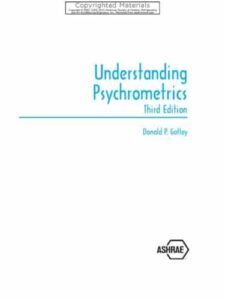Understanding Psychrometrics Third Edition
Understanding Psychrometrics Third Edition
Understanding Psychrometrics is a subscience of physics dealing with the properties and processes of moist air. Moist air is defined as a mixture of two gases: dry air and water vapour (the gas phase of H2O). Dry air within the troposphere is treated as a non-varying mixture of nitrogen (78.1%), oxygen (20.9%), argon (0.9%), and other trace gases, including carbon dioxide (<0.04%). Some broaden the definition of psychrometrics to cover mixtures of the gas of one substance (any dry gas component) and the condensable vapour of a second substance.
Understanding Psychrometrics is a basic science that underlies agricultural and aeronautical engineering; air conditioning; drying of crops, grains, and pharmaceuticals; dehydration; dehumidification; humidification; moisture control; meteorology; weather reporting; food science engineering; and piloting of aircraft. It is possible to work in these fields without a good understanding of fundamental-level psychrometrics by the use of shortcut formulae, tables, and charts. While it is true that designers can survive in these fields with minimal and incomplete psychrometric skills without creating many problems for themselves, their employers, and clients, there is no justification for this lack of knowledge when psychrometrics can be quickly learned.
You can also Read Chilled Water Plant Design Guide
Understanding Psychrometrics Third Edition Content
Acknowledgments
Preface
Preface to the Third Edition
Introduction
1—How to Use this Book
2—Etymology
3—Moist Air—The Psychrometric Substance
4—Water Vapour
5—Basics of the Psychrometric Chart
6—Underlying Theory and Algorithms
7—Ideal Gas
8—Psychrometric Pioneers and Charts from the First 100 Years
Part I: Psychrometric Pioneers
Part II: A Selection of Psychrometric Charts from the First 100 Years
Psychrometric Properties
9—Psychrometric Properties and Conventions
10—Dry-Bulb Temperature
11—Wet-Bulb Temperature
12—Dew-Point Temperature
13—Relative Humidity
14—Barometric Pressure
15—Specific Enthalpy
16—Specific Volume
17—Humidity Ratio
18—Water Vapour Pressure
Basic Psychrometric Processes
19—Psychrometric Processes
20—Process Calculations and Definitions of Sensible and Latent Enthalpy Change
21—Why Do Air-Conditioning Engineers Need Psychrometrics?
Processes in Meteorology
22—Adiabatic Expansion and Adiabatic Compression
Additional Information
23—Fan Temperature Rise
24—Frequently Asked Questions
25—Altitude Effects on Psychrometrics and HVAC
26—Psychrometric Program Listing and Comparison Table
Appendices
I—ICAO Equation Relating Barometric Pressure and Altitude
II—Water—Facts and Trivialities
III—Other Psychrometric Substances
IV—Charts, Tables, and Forms
V—Real Gas Models
Glossary
Bibliography
Index
Conversion Equalities: I-P to SI Units

Comments are closed.